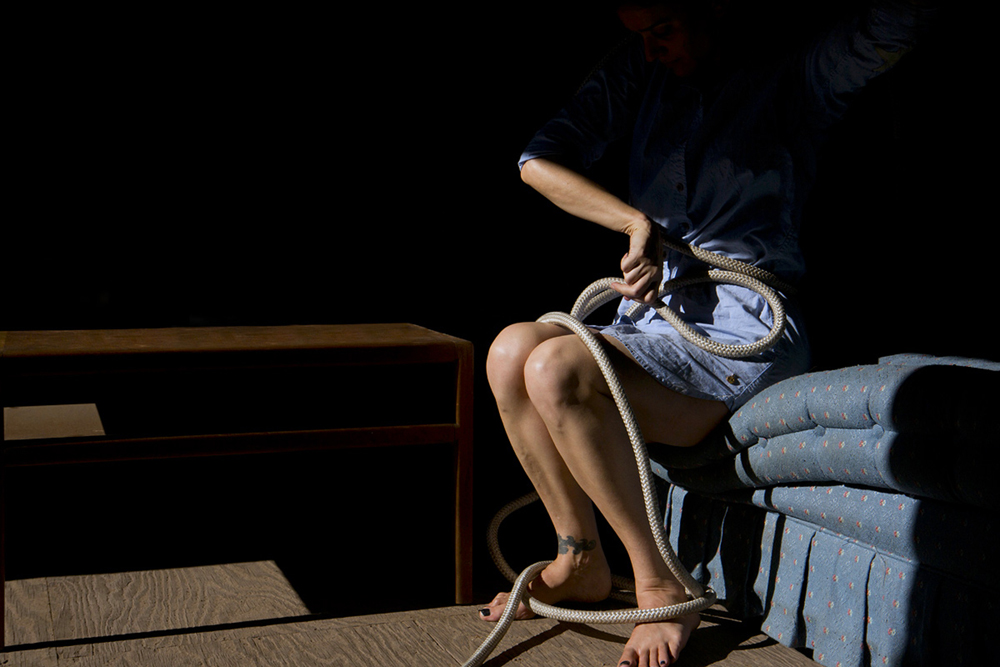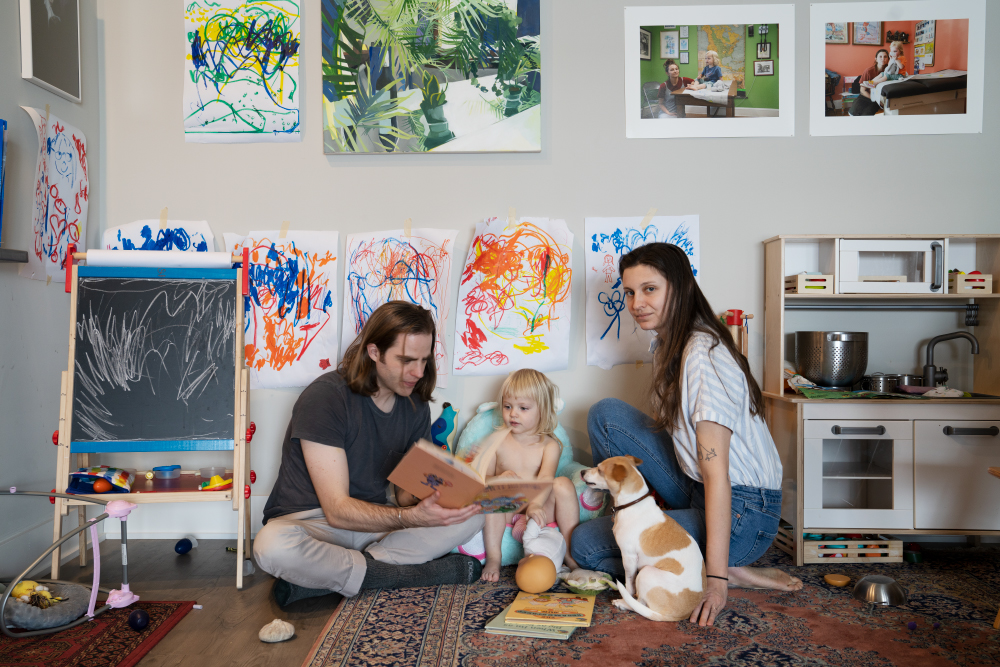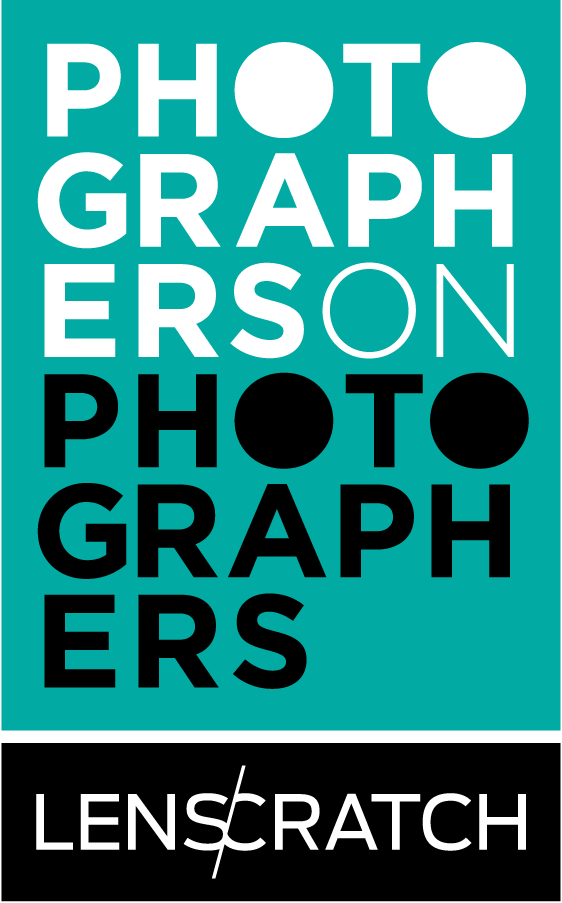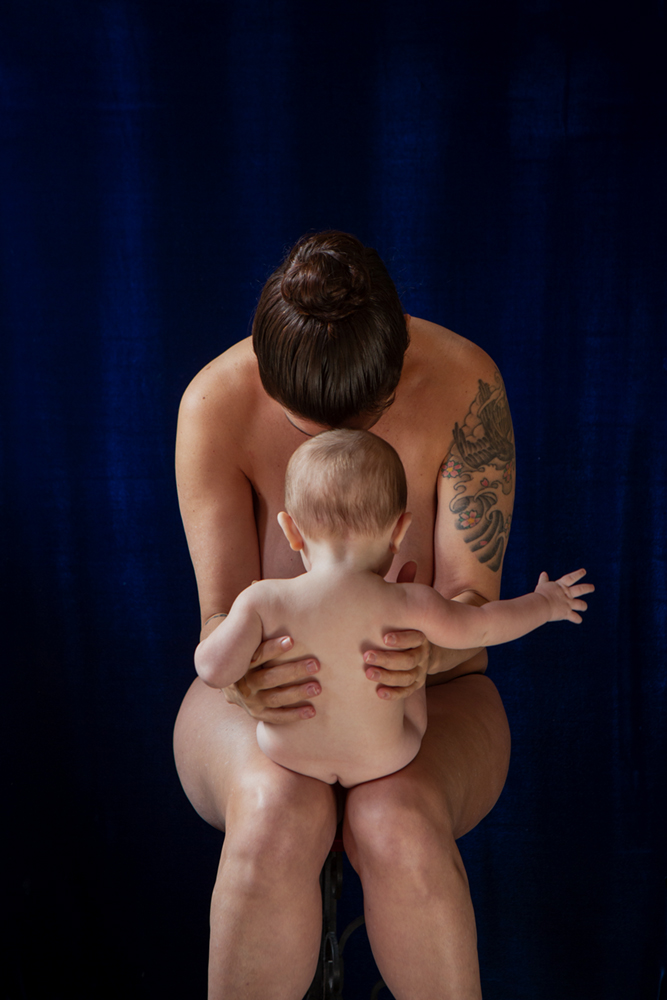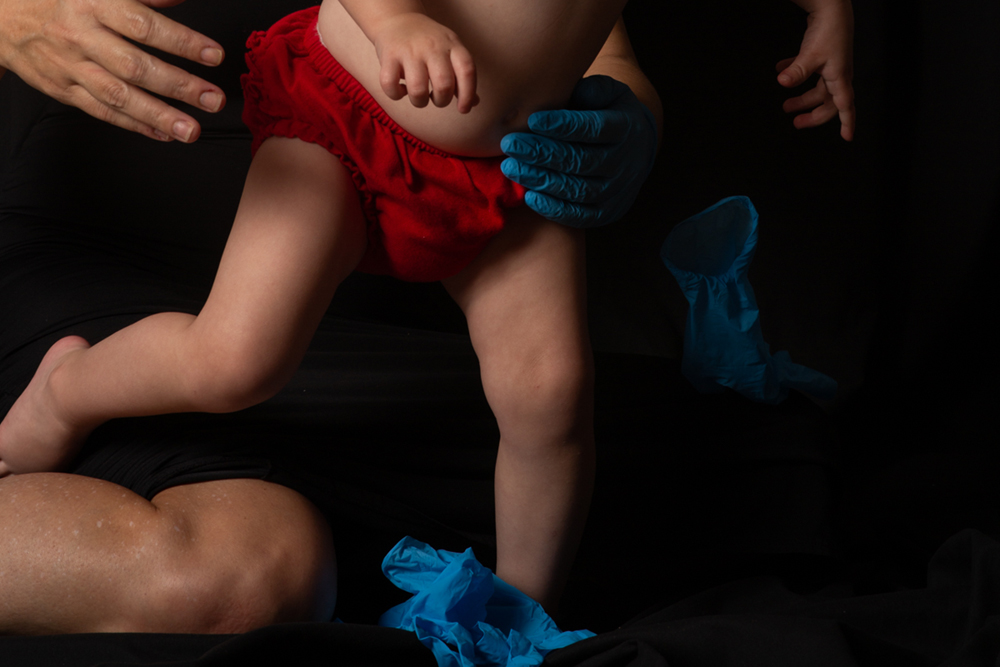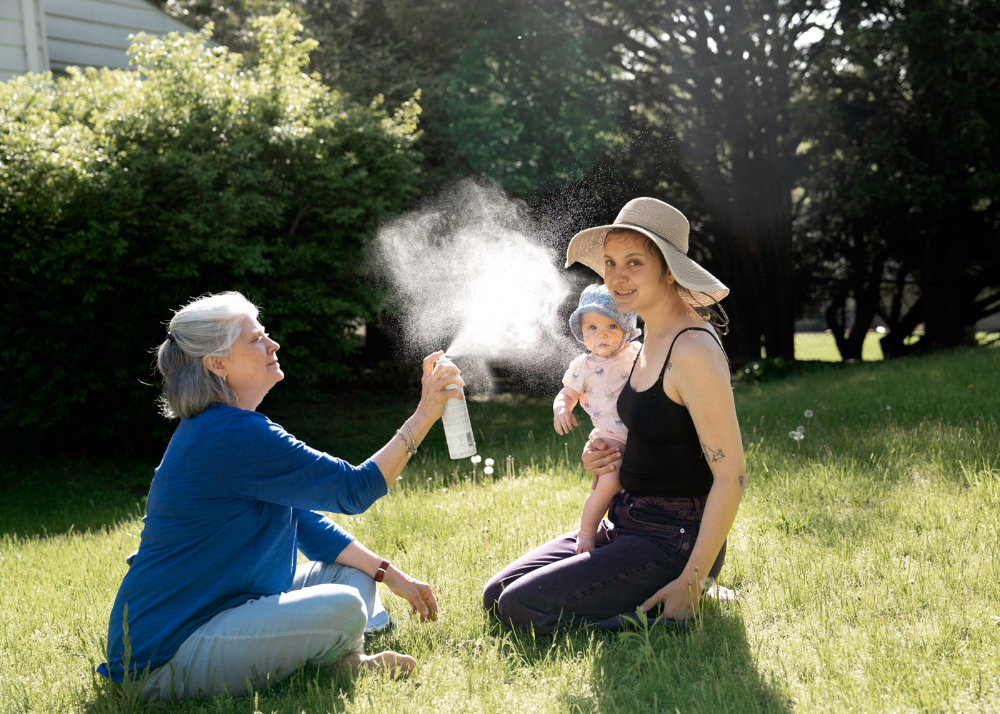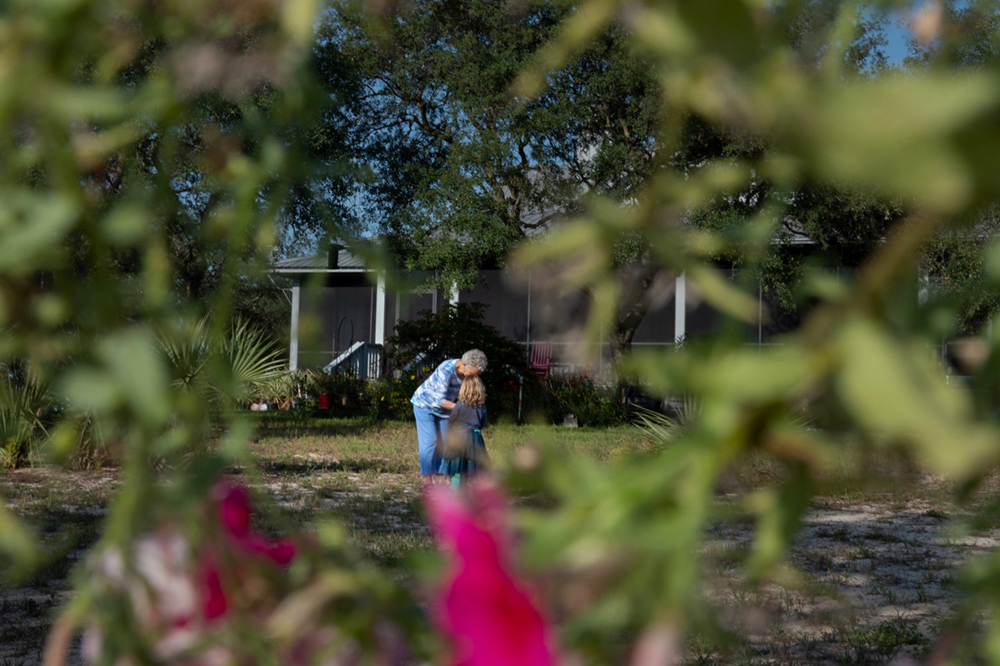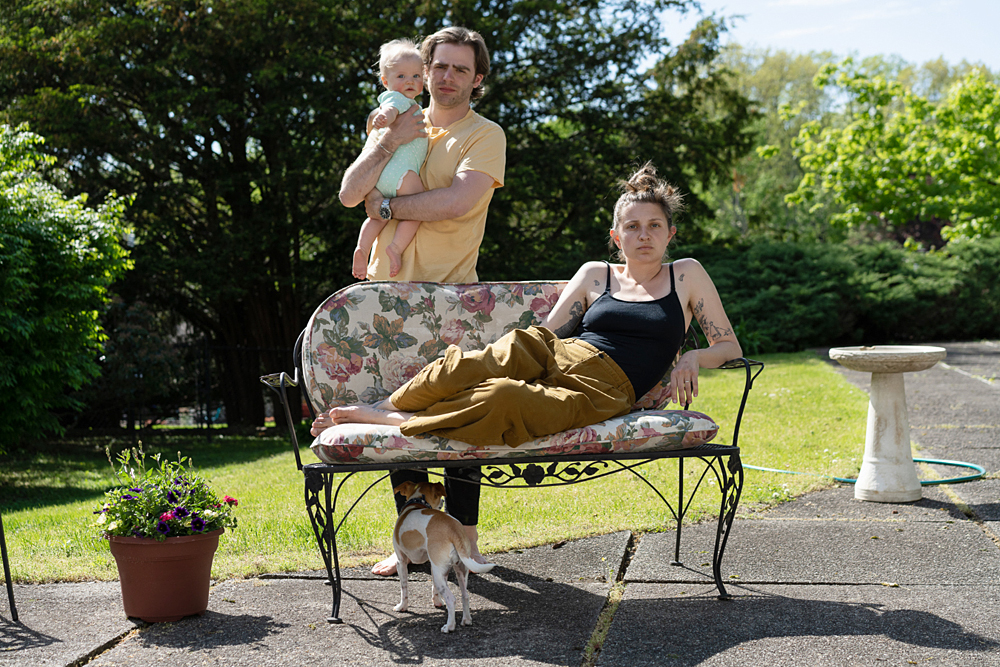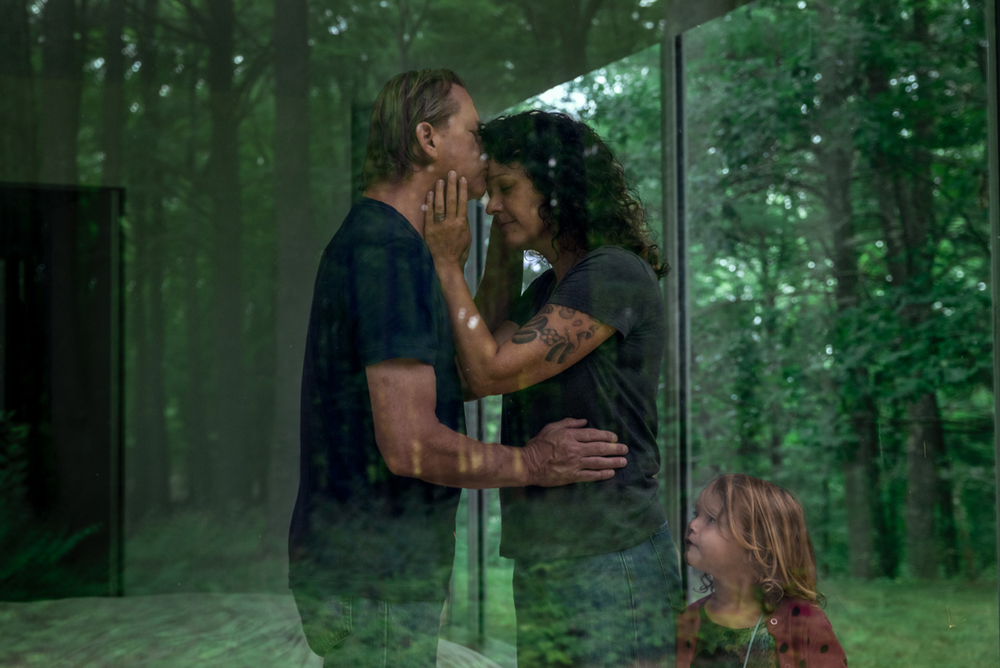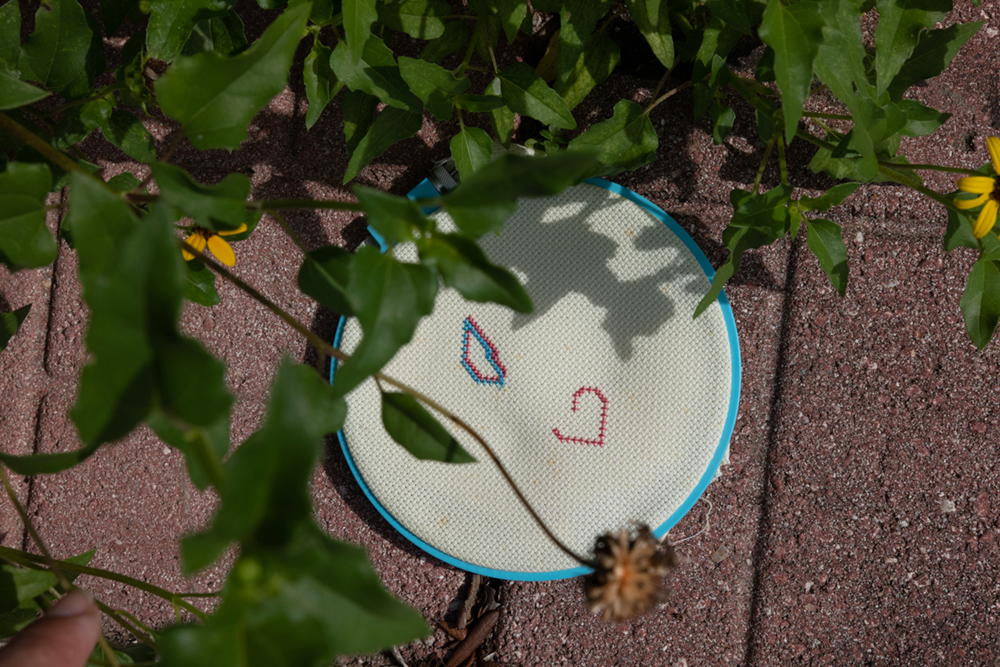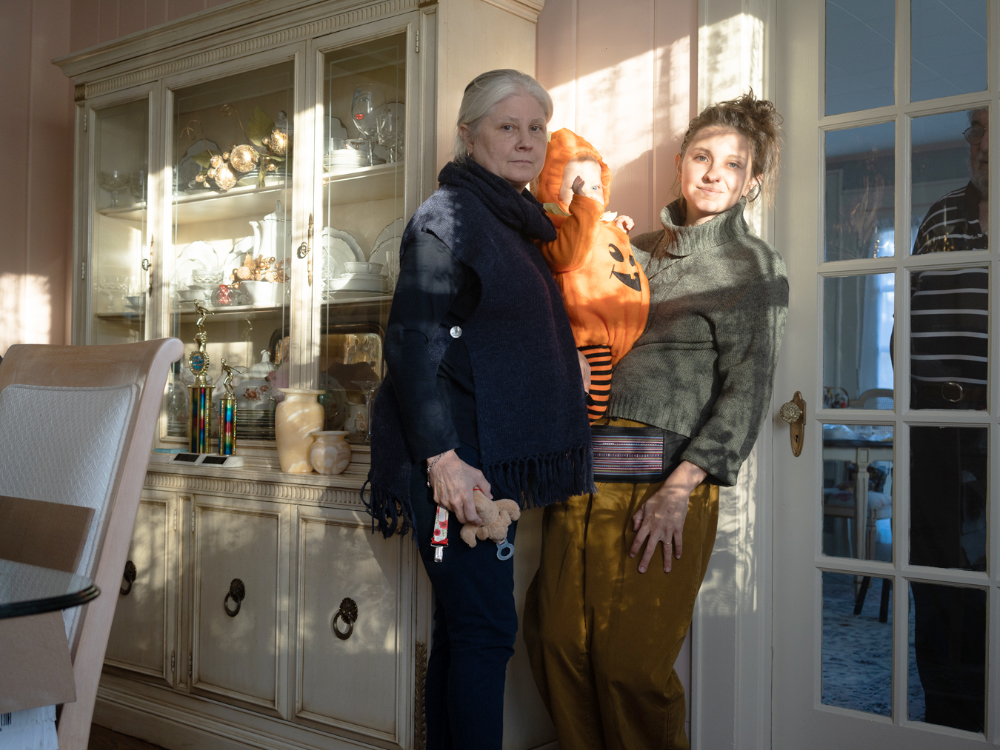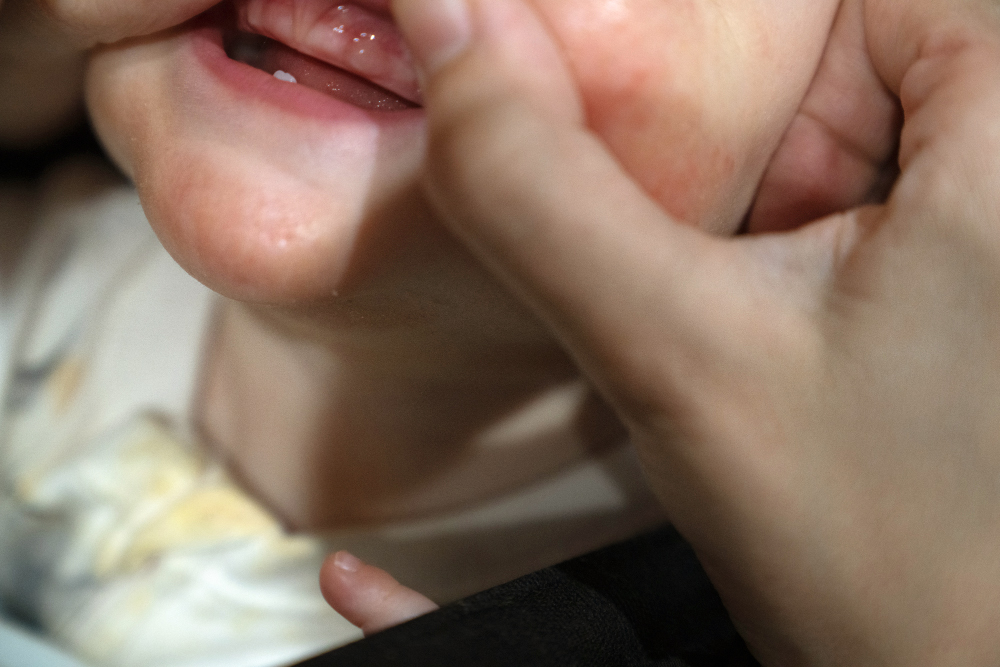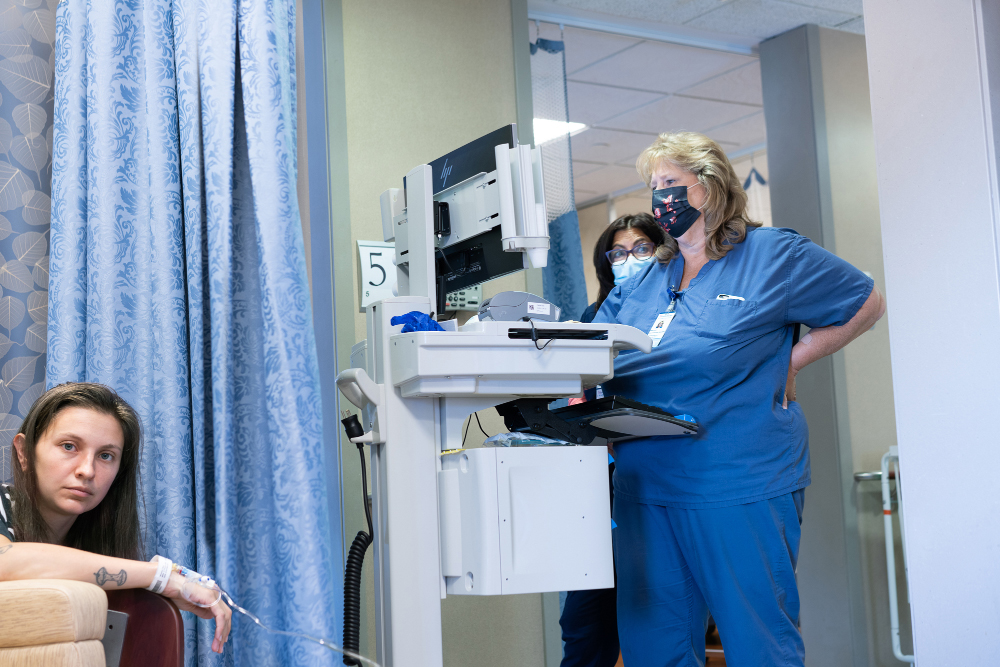Photographers on Photographers: Jennifer McClure and Sara J. Winston in Conversation
Photographers Jennifer McClure and Sara J. Winston are in conversation today, finding commonality in motherhood, art making, and the travails of doing it all, all at once. Both approach their documentation of self and parenting in different ways, both are participant observers of the everyday.
Sara J. Winston: I’m curious to know what interests or events in your life led you to become an artist; and if or how those interests and events may continue to influence the way you think of the work you make today.
Jennifer McClure: My father was a Marine and we moved all the time. I was a shy kid, and I had a hard time with that. I took a lot of photos to remember the friends I once had when I moved to a new place without any. I decorated my walls with these pictures, and I took great comfort in the visual narrative I created. I never imagined that making photographs could be a way of life or a career. I thought I wanted to be an English professor, but it was the story-telling that I loved rather than the teaching. I worked in restaurants and tried a few random jobs. I quit an office job that did not suit me, panicked about almost turning 30, and picked up The Artist’s Way by Julia Cameron. I learned that photography was the thing that brought me joy. I started taking Continuing Education classes at SVA and ICP as I could afford them.
It’s been a slow journey. I still take pictures as a way to memorialize my loved ones. I still need to see the pictures on a wall to have my life make sense. It’s taken a long time to make photographs say what I want them to say, to shape time rather than stop it.
JM: You seem to have known from an early age that photography was the medium for you. What was that like? Have you ever considered other paths?
SJW: I was very fortunate to have a parent who was always very vocal about the importance of education for education’s sake, and that one finds their way to a career as they pursue their education and passion. My parents were both pretty hands off, and as a teen I was given a lot of unmonitored space to explore my interests and figure things out for myself. The only interest that did not bore me over time was photography. So I worked like hell to get myself some scholarship money to pursue that path.
I began art school with an interest in journalism and the idea that one day I might work as a photojournalist. But when my studies and school assignments began, I quickly learned that I could not embed myself in other people’s lives in the way that is required in journalism. Instead, I found myself studying the craft and history of photography, and through that coursework I began to create my own visual language within the medium as an artist.
It was only after I finished my MFA that I became more interested in writing and the possibility of working in a hybrid image/text form. I certainly feel more confident and comfortable as a photographer than as a writer, but I believe a fair amount of discomfort, plenty of failure, and rigorous practice is required to achieve good work. So, I write!
SJW: The act of shaping time rather than stopping it with an image is exciting: to give 1/125 of a second form rather than prevent its passage. How has it felt to shape time with your daughter Esme, your collaborator, over the last few years? Have your ideas about what a photograph can communicate, and who your audience is, changed?
JM: Time in all forms is slippery with a child. In the beginning, I mainly took photos as a record. I was too tired to come up with ideas, and I also didn’t recognize my face or my body anymore. I was confused about how to photograph both of these new people. When she started walking, we began doing more creative and metaphorical photos. You can’t direct a toddler, at least not this one. I could make a plan for a picture, but I had to let go of any intended consequences and be open to her responses and desires. The result is usually more interesting than my original concept. I look for the surprises, the unexpected connections that move beyond a moment in time.
She has phases where she doesn’t want to do pictures at all, or she tells me to put the camera away after a few, and I respect her wishes. She also lately points out beautiful light and tells me where I should take pictures, so perhaps she just needed space and control. I think I’m still too close to all of these photos to understand what they mean, but I keep coming back to this quote by Emmet Gowin: “If you set out to make pictures about love, it can’t be done. But you can make pictures, and you can be in love. In that way, people sense the authenticity of what you do.” I’m still unsure who my audience might be, which holds me back from making a book about this.
JM: You have a very strong visual language. Your photographs are mysterious and intriguing. I’m curious about the image/text hybrid. How exactly are you incorporating words?
SJW: I first began to explore the image/text relationship in my book Homesick (Zatara Press, 2015). I made the photographs and Ani Katz wrote a series of short vignettes in response to the book’s images. Ani’s writing was included as a complete piece, printed after the image sequence in the book. In my book A Lick and a Promise (Candor Arts, 2017), with the encouragement and support of my collaborator and publisher Matt Austin, I included two pieces of writing: one piece written by me and the other written by my father. In this book the photographs are bookended by the writing. In both of these works the text can exist with or without the images, but together the text elevates the images and the images elevate the text.
In my current project, Our body is a clock (forthcoming), I am working with photographs made during my monthly intravenous medical treatments alongside short, fragmented pieces of my own writing. In the text I describe the physical and emotional impact of my medical infusion therapy and the porous boundaries that exist between my various caregivers and me, their patient. I’m interested in creating an experience of the psychological weight and insecurity of chronic sickness in the American healthcare system. I have not started the book design but I imagine that the text will be interwoven with the images.
SJW: I’m intrigued by Esme’s desire for control and direction in the pictures you two make. What is it like for you when Esme notices the quality of light and suggests that the two of you make a picture? Have there been any moments she has suggested that yielded an image you couldn’t have imagined without her impulse and vision?
JM: Your infusion photos are fascinating. I love how creative you’ve been with a process that is inherently boring. And I also love the exploration into being taken care of while you’re simultaneously learning how to take care of someone else. You said earlier that discomfort is required to achieve good work, and these photos are a form of proof. I’m excited to read what you write about this series.
Your daughter seems like such a willing participant in your photos. I like that you have your photos with her up on her wall, along with her artwork. That puts everything in the same category. Every image with Esme lately is completely dependent on her whims. I gave over control during the pandemic, when I had ideas for a series with Covid items and she rejected all of them. She rarely wants to participate lately if I set up the backdrop and lights. She likes to be outside when we make pictures these days, so my work has lots of plants and trees and water. When we do photos inside, they involve intricate arrangements of stuffies and plastic animals. I’m not sure what any of these mean, but I trust the process and keep taking them.
JM: How do you talk to Anita about making your work? How willing are all of your subjects to be photographed? I especially admire your mom’s presence in these. She’s a force.
SJW: Thank you, Jennifer. The infusion photographs are very emotional for me. The process of making the work and the resulting images are both frightening and empowering. It is always a treat to hear how they are perceived by others.
Anita is three, and so far there haven’t been many occasions where she has not wanted to make pictures or be photographed. I always say something like, “Hey! Let’s make something together. I’m going to get the camera.” She wants to help; she wants to take off the lens cap and she particularly loves to press the shutter and use the remote. At this age it seems like if something is exciting to me it is exciting to her too. I’m currently an artist-in-residence at ACRE in Stueben, Wisconsin, far from home, and as I was preparing her for my absence, I started talking to her about the pictures of us as my work rather than just something we do together. I had never framed our dance with the camera as work when talking to her before but I think from now on that will be part of the invitation as I go setup the camera. “Let’s do some work together.” When I was getting ready to leave for this residency I told her, “Sometimes Mommy has to go away to make her work. But she will come back; I will always come back.”
Photographing my mother is a different story.
During the first year of the pandemic my family of three lived with my parents for several months. When we moved in, Anita was about six months old. Within the first few days of our cohabitation I began making intergenerational self-portraits as a daily practice. Anita and I would go wherever my mom was. If we found her in bed, then Anita and I would crawl in with her and that would be the stage for the images that day. During that time my mother never objected. For all three of us–grandmother/mother, mother/daughter, daughter/granddaughter–that time together was a gift. It wasn’t until after we moved out that she objected to sitting for photographs as a trio. We are both sensitive and if either of us is hurt or irritated we cannot sit together for a picture. Somehow that was never an issue when we lived together.
SJW: Have you photographed your mother?
JM: I’ve tried. I have a hard time answering this one. She smiles in every photo, even if it’s a slight one. She won’t let me get a photo with her resting face, as she claims the smile is her resting face. There’s so much to unpack there. She’s already sensitive about some earlier work I made about having an unhappy childhood. I feel like she’s on edge when I try to photograph her, as if she thinks I’m trying to make her look bad. I certainly don’t want to make photos that cause the subject pain. I have ideas for intergenerational conceptual photos I’d like to do, but I’m not sure they’re possible. I would want to be honest about what I’m trying to convey, and historically, my honesty has not landed well. So I look from a distance.
JM: So interesting that your mom has stopped being willing, especially given the wonderful results. How is it working with your husband in photos?
SJW: Looking from a distance is very honest, and this photograph communicates a respect to honor that distance while remaining true to your impulse, desire, and need to photograph. It’s excellent.
The relationship between mothers and daughters can be turbulent–my relationship with my mom is–yet I find that making photographs together gives us an opportunity to bond and, in some ways, heal. However, we each have our own parameters for what makes a successful photograph. She wants the smiling picture while I desire the more honest expression that depicts what these moments might actually feel like. I’m reaching for the less sentimental view. These differences can exacerbate the friction that exists between us. Once my father commented on a print of my mom in my studio: “You like your mother, right? Judging by this picture it seems like you might not. This is not a picture a person makes of someone that they like.” Despite differences of opinion we continue, and I’m grateful.
My husband Topher is my favorite collaborator. He is very curious, patient, and caring; he believes and trusts in my vision which makes him a willing participant.
SJW: How do you decide when a moment is one for a self-portrait with Esme, with all three of you, or just one of you alone? Is it something you previsualize, or is it more dependent on Esme’s whim to be pictured with you or with you and her dad?
JM: The honest expression is what I’m after as well. I try to take sentimental ones separately, being clear about which ones are for my work. Some people are into it, others not so much. My nephews know the drill and never smile for me. I love it. And what your dad said about your mother photos is intense! People have expectations of what “good” photos look like from a lifetime of conditioning.
I started making portraits with and of Esme because we spent all our time together, while my husband worked outside the home full-time. I had no desire to do any alone. I saw that she was physically changing very quickly and that I could not visually remember the baby she was a few weeks prior. I would force myself to bring out the equipment, and I would look at it for days before finally working. I have thousands of candid photos of Brad and Esme together, especially when he started working from home in the pandemic. Those are easy. I’m taken by a moment or the light, and I grab my camera. When I do scenarios of the three of us, I usually have a general idea but let the situation unfold as it may. I tend to make more work when we go on vacations, which I’m sure drives them crazy. So I will previsualize according to the location and what I’m feeling about the three of us at the moment, and then get everything in place. I have a very short window in which I can hold both of their attention. She will usually spend the entire session trying to make him laugh. I find these much more difficult. I’ve not been consistent in making solo self-portraits, and I realize this is because I’m not sure who I am these days. I feel formless and shapeless, and I have no idea what I’m trying to say anymore. It’s a strange place to be.
JM: Lately I’ve been thinking more about making still lifes that convey my emotional state. You do this so well. Do you make the photograph first based on instinct and then assign meaning? Or are they more intentional from conception?
SJW: It’s been a little while since I’ve made a classic still life, but my still life images and the self-portraits both come from a place of intuition and curiosity. I have intentions, but I don’t assign the images meaning. Instead I allow the images to do the work to show me their meaning as I continue working.
I spent a long time making only still life photographs. Often they were analytical and formal studies of things. I was perplexed by my cultural indoctrination of the importance of stuff, and in this period I was a hunter. I’d travel around and document objects where I found them, or bring them back to my studio and make formal portraits of things. But then, in 2015 I experienced a significant Multiple Sclerosis flare that changed the way I approached and thought about my work. I woke up one morning and I couldn’t see the world past my arm’s length; everything beyond my fingertip was doubled and blurry. During this period I looked at the world relying on the autofocus function of my camera, something I had never done before, and the photographs allowed me to see again. The camera functioned as an assistive device, processing the world when my body was unable to do that work. This was happening while I made Homesick and much of A Lick and a Promise. Once my vision improved I didn’t return to hunting for objects. I began photographing myself during my monthly immunotherapy and my body became a subject in the frame to be studied. First my hand and the site of the IV port; then my arm and the netting that holds the wires together; and later, more formal views that show my full likeness framed by the objects of the hospital, or framed by the objects of my home during home-care.
SJW: I like your idea to turn to still life to work through a period of uncertainty. I would love to see some of those images. Have you started to make them? I wonder about other ways to untangle moments of confusion. What are you listening to or reading? Do you find other media helpful?
JM: I can’t imagine how frightening it must have been to lose sight, let alone all of the other complications. You must have been in pure survival mode. I can see why your whole way of photographing changed. I know what it’s like to feel like your body is betraying you. There was a great deal of denial and anger for me, before realizing that I had to learn to live differently. That wishing these things away wouldn’t work. I admire how you’ve handled your illness with such grace. I frequently can’t tell how I feel about what’s happening with my body until I study the photographs I make. I wonder how you would have processed had you not had the camera to help you.
I keep making still lifes but they look awkward to me. I feel like I’m trying too hard to force the symbolism, I am hoping that they’ll make sense in a sequence. I lack patience for that sometimes. I have two boxes full of things, some from my childhood and some that I’ve ordered on eBay. I know they’re important. I need time to sort them through and live with them. Let them tell me what they need. I’ve been reading a lot of poetry about motherhood for inspiration. The poems help me take these big ideas and break them into discrete entities. I like using the words as jumping off points for photographs, like very loose stage directions. The School for Good Mothers by Jessamine Chan blew me away. And I loved The Hotel by Sophie Calle, now that I’ve finally had time to read the text.
JM: So many of your photographs feel like classically arranged paintings, with a modern twist. Where do you find your inspiration? Do you compose pictures ahead of time or seize the moment?
SJW: I work intuitively and in the moment. I notice something, try to move quickly and get my camera on the tripod, compose my stage through the viewfinder, and with the remote in hand I step into the frame.
I am often inspired by moments from my everyday life. It feels grounding to slow down and practice looking closely, with and without my camera.
I think about French writer Georges Perec’s assertions about the infra ordinary often. What happens when nothing happens? Perec was fascinated with the ordinary and habitual aspects of everyday life, and described the minute situations, gestures, moments, and habits that are often overlooked or missed as being of paramount importance and, in my view, fodder for creativity:
“What’s really going on, what we’re experiencing, the rest, all the rest, where is it? How should we take account of, question, describe what happens every day and recurs everyday: the banal, the quotidian, the obvious, the common, the ordinary, the infra-ordinary, the background noise, the habitual?” (Perec, The Infra-Ordinary, 1973)
I really enjoy reading. Lately I’ve been turning to Of Woman Born: Motherhood as Experience and Institution by Adrienne Rich (W.W. Norton and Company, 2021); The Emperor of all Maladies by Siddhartha Mukherjee (Scribner, 2011); Modern Instances: The Craft of Photography by Stephen Shore (Mack, 2021); Theater of Manners by Tina Barney (DAP, 1997); Ruth on the Phone by Nigel Shafran (Roma Publications, 2012); and Face to Face by Seichi Furuya and Christine Gössler (Chose Commune, 2020).
SJW: I’m intrigued thinking about the things you’ve been collecting on Ebay. Your mention of this material makes me wonder: do you work on multiple projects at once? Or do you not organize your work into distinct projects until later when there is a need to mark something’s beginning and ending?
JM: I feel like the moment and the light are gone before I can put myself in the picture. I wish I could find the boredom fascinating. Perhaps I need to look harder, stare longer. I used to be better at soaking in all of the details. But now that we’re coming up on four years of full-time childcare, my brain is so ready for something different. I know that in ten years, I’ll long for these quiet moments. I frequently take photos simply to exercise my creative muscles, not necessarily because I’m inspired, and those often carry so much significance later. Photographing the mundane often gets me out of a slump but I never seem to remember that when I’m struggling.
I tend to go one at a time when it comes to making work. For a couple of projects, I had a framework. The series set in hotel rooms where I examined my past relationships had distinct parameters. I was surprised by the photos and emotions, but I knew for sure when it was finished. I have no idea where my current work is headed, and that’s unsettling. Photographing these objects feels like it’s connected to the staged portraits and the candid scenes I’ve been making for four years but I honestly don’t know. I think a great editor could weave all of these elements into one project. It’s hard for me to sit with this work and let it simmer the way it needs to. In this current photo climate, there seems to be constant pressure to produce.
JM: How did you know that your current work was ready for a book format? And how did you come to work with your publishers? Seems like such a great fit.
SJW: I’m always photographing with the book form in mind. I love everything about the book object and the process of making a photobook. I love the work involved in creating the thing and the community efforts that go into putting a book out into the world.
Deciding when the work is ready is a personal decision. For me it is a constellation of factors: some time spent photographing and sequencing, (in the case of Our body is a clock it has been seven years) combined with a blend of instinct, faith, courage, and resources. I want to unpack what I mean by resources. It isn’t only a matter of financial resources, but also of time, energy, and focus because as an artist with a full time job and a family it is a challenge to make the scales balance properly. It needs to feel right in all of those areas.
I started out self publishing my work and bringing copies of my books to book fairs like the New York Art Book Fair at MoMA PS1. I kept in touch with people who I met there and over time some of those relationships blossomed into friendships. The artist book and photobook world is small, and it is a friendly and passionate community. I’ve had success with cold email submissions, as well as responding to open calls to submit full manuscripts. But finding the right fit takes time and work. It is ultimately about relationship building and that of course takes time. A good relationship between artist and publisher is important!
SJW: I believe that letting thoughts and images simmer is important, and that as you sequence the images they reveal things to you. You’ve said a few times in our conversation that you’re still figuring out what the work you’ve been doing (over the last four years) might mean, or where it’s going. How do you contend with that? Do you share images with friends and colleagues, take breaks, or photograph through the sticky times?
JM: I share images with a few friends. I apply for grants periodically, which forces me to look at the bigger picture. That can often be more confusing. I also finally gave myself permission to take a break this year. I realized my kid needed me to be her mom more than I needed to make work. But I get restless when I’m not photographing on a regular basis.
Like you said, there’s only so much time in a day. I have enough bandwidth to be with my family, teach, and make new work. There’s so much more to having a successful career than that. I need to edit, research, write, market, promote, fundraise, etc. It can be overwhelming, so I retreat into the creative part of it all. At some point, I have to do more. This conversation has been so motivating in regards to making a book! I’ve been looking at all of the work I’ve made over the past ten years and wondering if that’s actually all one project. My daughter starts pre-K in September, and maybe that’s a good stopping point. Or at least a good time to take stock and to experiment with the still life photographs I’ve been contemplating. The finance part of it all scares me, but I might have a better idea of where to look for funding when I know what the work is about. And that might be the root of it all, that I haven’t wanted or had the capacity to look deeper.
Thank you for sharing so much of yourself and your process! I am grateful and inspired!
SJW: One last book that has been critical for me that I highly recommend is Mother Reader: Essential Writings on Motherhood Edited by Moyra Davey (Seven Stories Press, 2001). But the fact remains that there aren’t very many models for working artist-mothers other than those at the apex of their medium. Please be kind to yourself! There will be time and bandwidth down the road to figure out all of the details you’ve just mentioned.
Thank your time and generosity, Jennifer!
Jennifer McClure is a fine art photographer based in New York City. Her work is about solitude and a poignant, ambivalent yearning for connection. Her first book, You Who Never Arrived, was published by Peanut Press Portfolios in 2020. She was a 2019 and 2017 Critical Mass Top 50 finalist and twice received the Arthur Griffin Legacy Award from the Griffin Museum of Photography’s annual juried exhibitions. Jennifer was awarded CENTER’s Editor’s Choice by Susan White of Vanity Fair in 2013 and has been exhibited across the country. She has taught workshops for Leica, International Center of Photography, Los Angeles Center of Photography, the Maine Media Workshops, and the Griffin Museum. Her work has been featured in publications such as National Geographic, Vogue, GUP, The New Republic, Lenscratch, Feature Shoot, L’Oeil de la Photographie, The Photo Review, Dwell, and PDN. She also founded the Women’s Photo Alliance in 2015.
Follow Jennifer McClure on Instagram: @jmcclurephoto
Sara J. Winston is an artist based in the Hudson Valley region of New York. She uses photographs, text, and the book form to describe and respond to chronic illness and its impact on the body, mind, family, and memory. Sara earned her MFA from Columbia College Chicago in 2014. She is the author of A Lick and a Promise (Candor Arts, 2017) and Homesick (Zatara Press, 2015), and has contributed work to several print publications, including Return to the Field (Wendy’s Subway, 2021) and Issue #9: Other Eden (Papersafe Magazine, 2017). Sara currently works as the Photography Program Coordinator at Bard College, is on the faculty of the Penumbra Foundation Long Term Photobook Program, and serves as a mentor in the Image Threads Photobook Mentorship Program. She has book projects forthcoming with Skylark Editions (Chicago, IL), Molto Molto (Brighton, UK), and Push Pull Editions (Corvallis, OR).
Follow Sara J. Winston on Instagram: @sarajwinston
Posts on Lenscratch may not be reproduced without the permission of the Lenscratch staff and the photographer.
Recommended
-
Earth Week: Aaron Huey: Wallpaper for the End of the WorldApril 26th, 2024
-
Earth Week: Casey Lance Brown: KudzillaApril 25th, 2024
-
Tara Sellios: Ask Now the BeastsApril 6th, 2024
-
ALEXIS MARTINO: The Collapsing Panorama April 4th, 2024
-
Emilio Rojas: On Gloria Anzaldúa’s Borderlands: The New MestizaMarch 30th, 2024

